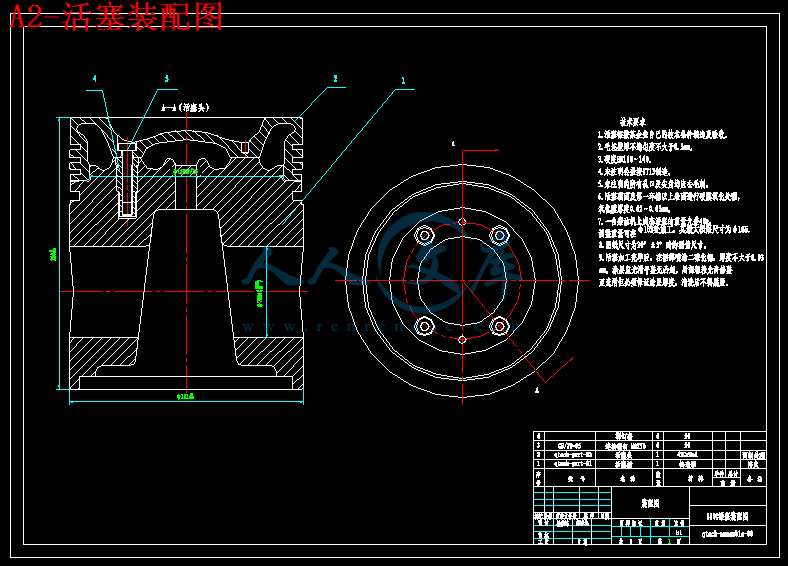摘 要
在柴油机气缸内,活塞在一部分工作循环压缩气体,而在另一部分工作循环气缸内混合气体燃烧膨胀使活塞顶面承受高温(约569C)高压(约116~120Kgf/cm2)气体的作用,并把压力通过活塞销、连杆传给曲轴。可见,活塞是在高温高压下作长时间连续变负荷的往复运动,它的负荷和工作环境很恶劣。在本设计中将对活塞的加工工艺进行设计,以保证活塞长久稳定工作。现将设计中所做的工作简要介绍如下:
180C柴油机活塞加工工艺合理性是很重要的,通过对零件的作用及工艺方案分析,拟定毛坯的制造形式及工艺路线,通过分析、比较,采用了相对集中加工工艺方案,最终确定比较合理的机械加工工艺路线。制定工艺路线时主要考虑粗、精加工安排、加工方法选择、工序集中与分散、加工顺序等方面的要求。接着确定加工余量、工序尺寸,经过对工序特点的分析,恰当选择相应加工设备和工艺装备。接下来经过计算查表确定活塞各主要工序的切削用量并绘制工序卡片,最后设计夹具。设计夹具时,要多方面考虑,严格要求,机床夹具的好坏直接影响工件加工表面的位置精度。所以,机床夹具设计是装备设计中的一项重要的工作,是加工过程中最活跃的因素之一。在本毕业设计中特别设计了定位准确、结构简单和使用方便的精镗销孔夹具。
关键字:活塞;工艺路线;加工设备;切削用量;夹具
Abstract
In diesel engine cylinder, the piston part of the cycle in the compressed gases, and in another part of the work cycle of the combustion gas mixture within the cylinder so the piston top surface expansion high pressure (about 116 ~ 120Kgf/cm2)under high temperature (about 569°C) gas role, and the pressure through the piston pin, connecting rod to the crankshaft. Can be seen that the piston is a long time under high temperature and high pressure in continuous reciprocating motion of the load, its load and working conditions were appalling. During the design process of the piston will be designed to ensure long-term stability of the work piston. The design of the work done by a brief introduction as follows:
Diesel Engine Piston 180C reasonable processing technology is important, the role of parts and technology program analysis, preparation of rough form and process manufacturing line, through the analysis, comparison, use of the relative concentration of processing programs, and ultimately more reasonable to determine the mechanical line processing. The development process of rough line the main consideration, finishing arrangements, choice of processing methods, centralized and decentralized processes, such as processing the order requirements. Then determine the allowance, process size, after the analysis of the characteristics of the process, select the appropriate processing equipment and technical equipment. Calculated look-up table to determine the next major piston cutting process and the mapping of processes card, the design of the final fixture. Fixture design, it is necessary to take various aspects into account, the strict requirements of the fixture a direct impact on the surface of the workpiece processing position accuracy. Therefore, the machine tool design fixture design is an important task is the processing of one of the most active. During the graduation project in a specially designed positioning accuracy, simple structure and easy-to-use precision pin hole boring jig.
Keywords: Piston; Technology; processing equipment; cutting; Fixture
目录
摘要……………………………………………………………………Ⅰ
Abstract………………………………………………………………Ⅱ
目录………………………………………………………………………Ⅲ
第1章 序论………………………………………………………… 1
1.1 180 C柴油机活塞的由来 ……………………………………………………1
1.2 机械加工工艺规程………………………………………………………………7
第2章 180C柴油机活塞零件图的分析 ………………………………8
2.1 活塞的功用……………………………………………………………………8
2.2 活塞的结构特点和技术要求 …………………………………………………8
2.3 180C活塞的工作情况 …………………………………………………………9
2.4 180C组合活塞结构 ……………………………………………………………10
第3章 活塞加工工艺制定 …………………………………………12
3.1 计算生产纲领确定生产类型 …………………………………………………12
3.2 审查零件图图样工艺性 ……………………………………………………12
3.3 选择毛坯 ………………………………………………………………………12
3.4 工艺过程设计 ………………………………………………………………13
3.5 确定加工余量及毛坯尺寸、设计毛坯图 …………………………………25
3.6 部分重要工序设计 ……………………………………………………………29
3.7 确定切削用量及基本用时 …………………………………………………33
第4章 夹具设计……………………………………………………50
4.1 机床夹具概述 ………………………………………………………………50
4.2 机床专用夹具设计的基本要求 ……………………………………………50
4.3 活塞夹具的设计思路 …………………………………………………………51
4.4 活塞裙精镗销孔夹具设计 ……………………………………………………51
结论…………………………………………………………………56
参考文献…………………………………………………………57
致谢…………………………………………………………………58
附件 1…………………………………………………………59
附件 2…………………………………………………………81
第1章 序论
1.1 180C柴油机活塞的由来
180C柴油机是四方机车厂与奥地利AVL公司合作开发的。下面就四方机车厂和AVL公司的发展历史做一下介绍,从他们的发展过程中,我们能看到柴油机行业的一些趋势以及中国柴油机的发展历程。
(1)四方机车厂的光辉历史
四方厂在1958年9月22日试制成的东风型内燃动车的基础上,于1959年4月10日制成了国产第一台液力传动内燃机车--卫星型客运内燃机车。机车装用2台仿西德的12V175Z型柴油机,装车功率2×1000马力,最高速度140km/h。
上述早期试制内燃机车的特征:一是机车或柴油机基本是仿制国外的产品:二是直流电力传动匹配二冲程中速柴油机和四冲 程高速柴油机;三是液力传动匹配高速四冲程柴油机;四是设计技术水平较低,可靠性较差。
早期内燃机车的试制及尔后各工厂、研究所进行的大量试验研究和设计改进工作,为国产第一代内燃机车的设计和生产奠定了基础,也为我国铁路内燃化拉开了序幕。





![活塞工序图[9张].gif](/ueditor/net/upload/2015-06-29/9c4e04be-059d-4c34-ab28-69105c749ead.gif)
 川公网安备: 51019002004831号
川公网安备: 51019002004831号